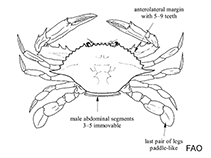Thalamita danae Stimpson, 1858
| Native range | All suitable habitat | Point map | Year 2050 |

|
| This map was computer-generated and has not yet been reviewed. |
| Thalamita danae AquaMaps Data sources: GBIF OBIS |
Upload your photos
Google image | No image available for this species;
drawing shows typical species in Portunidae.
Google image | No image available for this species;
drawing shows typical species in Portunidae.
Classification / Names Common names | Synonyms | CoL | ITIS | WoRMS
Malacostraca | Decapoda | Portunidae
Environment: milieu / climate zone / depth range / distribution range Ecology
Reef-associated; depth range 1 - 114 m (Ref. 96667). Tropical
Distribution Countries | FAO areas | Ecosystems | Occurrences | Introductions
Indo-Pacific: Mozambique to Mauritius and the Philippines.
Length at first maturity / Size / Weight / Age
Maturity: Lm ?, range 3 - 6.1 cm
Maximum depth from Ref. 106682. Intertidal (Ref. 8752) and subtidal (Ref. 106854). A swimming crab inhabiting the lower intertidal zone, hiding under boulders or burrowing in mud (Ref. 127107). Has a broad diet; feeds ravenously on the mussel Perna viridis (Ref. 102692). Also feeds on macroalgae and small invertebrates (Ref. 95905).
Life cycle and mating behavior Maturity | Reproduction | Spawning | Eggs | Fecundity | Larvae
Members of the order Decapoda are mostly gonochoric. Mating behavior: Precopulatory courtship ritual is common (through olfactory and tactile cues); usually indirect sperm transfer.
Main reference
References | Coordinator | Collaborators
Estampador, E.P. 1959. (Ref. 81840)
IUCN Red List Status (Ref. 130435)
CITES status (Ref. 108899)
Not Evaluated
CMS (Ref. 116361)
Not Evaluated
Threat to humans
Poisonous to eat (Ref. 130551)
Human uses
| FishSource |
Tools
More information
Internet sources
BHL | BOLD Systems | CISTI | DiscoverLife | FAO(Publication : search) | Fishipedia | GenBank (genome, nucleotide) | GloBI | Gomexsi | Google Books | Google Scholar | Google | PubMed | Tree of Life | Wikipedia (Go, Search) | Zoological Record
Estimates based on models
Preferred temperature
(Ref. 115969): 24.3 - 29, mean 27.8 (based on 1142 cells).



